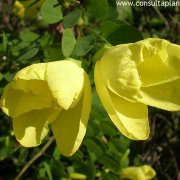Care of the tree Bauhinia tomentosa or Yellow bauhinia |
|
The genus Bauhinia, family Fabaceae, comprises more than 200 species of trees and shrubs native to tropical regions on all continents. Some species are: Bauhinia tomentosa, Bauhinia natalensis, Bauhinia galpinii, Bauhinia forficata, Bauhinia augusti, Bauhinia purpurea, Bauhinia variegata, Bauhinia blakeana. Common names: Yellow bauhinia, St. Thomas Tree, Yellow bell orchid tree. This species is native to South Africa, Mozambique, Zimbabwe, Tropical Africa, India and Sri Lanka. They are small trees or large semi-deciduous shrubs that reach 5 meters (16.4 feet) in height. The leaves are ovate in shape, leathery in texture and divided into two lobes. The interesting flared and hanging flowers are yellow with a dark center. They can bloom from late summer to early winter. They produce pod-shaped fruits. St. Thomas Tree is used in rock gardens, in small gardens as isolated specimens, in large pots for patios or in bushy groups. It's also used for bonsai. In the regions of origin it is used as a medicinal plant to treat diarrhea, dysentery and throat conditions. Yellow Bauhinia needs full sun exposure and warm or temperate temperatures; withstand frost down to -2 ºC (28.4 ºF). The soil must be well drained and contain enough organic matter; Add a layer of leaf mulch to the base of the plant. The transplant is done in early spring. Water moderately, waiting for the soil to dry out. Fertilize in late winter with compost or manure. Prune lightly in winter to control growth; Yellow bauhinia is a fast growing plant that can bloom from the second year of life. Bauhinia tomentosa is not usually attacked by the usual pests and diseases. Yellow bell orchid tree propagates from seeds sown in spring. |
Images of the tree Bauhinia tomentosa or Yellow bauhinia |
Find plants
Bauhinia tomentosa or Yellow bauhinia | Care and Growing
© 2025 FavThemes


